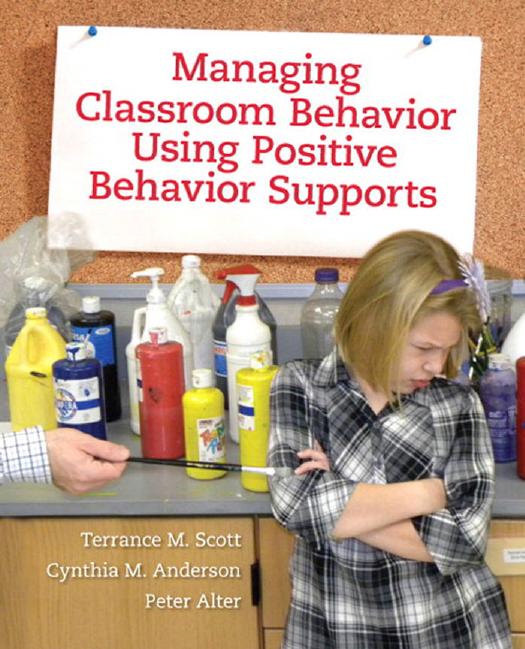Managing Classroom Behavior Using Positive Behavior Supports 1st Edition by Terrance Scott, Peter Alter, Cynthia Anderson ISBN 9780133467130 0133467139
$70.00 Original price was: $70.00.$35.00Current price is: $35.00.
Instant download Managing Classroom Behavior Using Positive Behavior Supports Terrance M. Scott after payment
Managing Classroom Behavior Using Positive Behavior Supports 1st Edition by Terrance M. Scott, Peter Alter, Cynthia M. Anderson – Ebook PDF Instant Download/Delivery: 9780133467130 ,0133467139
Full dowload Managing Classroom Behavior Using Positive Behavior Supports 1st Edition after payment

Product details:
ISBN 10: 0133467139
ISBN 13: 9780133467130
Author: Terrance M. Scott, Peter Alter, Cynthia M. Anderson
This is the eBook of the printed book and may not include any media, website access codes, or print supplements that may come packaged with the bound book. An essential how-to guide to positive behavior support in schools. Written as a methods manual for positive behavior support (PBIS) in school settings, this first edition text focuses on practical strategies for the classroom with step-by-step application examples. After an opening chapter that reviews the key literature and concepts related to evidence-based practice in positive behavior support, the text quickly moves on to a well-organized collection of indispensible tutorials, methods, and applications for teachers written in clear, down-to-earth language and supplemented with real-life examples
Managing Classroom Behavior Using Positive Behavior Supports 1st Edition Table of contents:
1 Introduction to a Prevention-Focused Model of Behavior Support
Chapter Objectives
Discipline Problems in the School
The “Causes” of Misbehavior
Summary
Proactive Management
Preventing Failure by Promoting Success
Prevention and the Academic–Social Behavior Connection
A Three-Tiered Approach to Proactive Management
Chapter Review
Application
References
2 Understanding Behavior
Chapter Objectives
A Functional Approach
Assumptions of a Functional Model
Behavior Is Learned
Behavior Is Lawful
Behavior Can Be Changed
Applying the Functional Model to Student Behavior
Define What the Person Says or Does
Identify Key Features of the Environment
Antecedent Events
Consequences
Chapter Review
Application
References
3 Overview of a Functional Approach to Intervention
Chapter Objectives
Assessment From a Functional Perspective
Function of Behavior
Functional Behavior Assessment
Step 1: Defining Behavior
Step 2: Assess Predictable Patterns
Step 3: Developing a Hypothesis About the Function of Behavior
Conducting an FBA
Summary: Understanding Behavior Through a Functional Behavior Assessment
Chapter Review
Application
Reference
4 Measuring Behavior in the School
Chapter Objectives
Defining Behavior
Dimensions of Behavior
Measurement Process
Step 1: Determine What to Monitor
Step 2: Determine the Simplest Way to Collect Data
Step 3: Monitor Behavior in a Consistent Manner
Step 4: Use Data to Evaluate and Make Decisions
Behavior Monitoring Methods
Event-Based Recording
Time-Based Recording
Decision Model
Chapter Review
Application
5 Using Data to Make Instructional Decisions
Chapter Objectives
Scope and Sequence: What Should be Taught First, Second, and So On?
Performing a Task Analysis: How Is It Done?
Goals and Objectives: Plans for Teaching and Evaluation
Educational Goal Statement
Instructional Objectives
Writing Instructional Objectives: Process
Evaluating Instruction
Graphing Behavior: Visual Representations of Performance
Evaluating Performance
Aim Lines
Trend Lines
Data-Based Decision Making
Determining the Effectiveness of the Plan
Decisions: Successful Performance
Decisions: Failed Performance
Chapter Review
Application
References
6 A Function-Based Perspective of Classroom Management
Chapter Objectives
Rationale for Assessing a Classroom
Matching the Intervention to the Classroom
Emphasizing Educative Behavior Management
Conducting a Functional Behavior Assessment of the Classroom
Focus on Functional Routines
Using a Scatter Plot to Identify Problematic Routines
Antecedents and Consequences
Antecedent Variables
Setting Events and Contextual Variables Affecting Behavior in the Classroom
Activities as Possible Setting Events
Discriminative Stimuli
Identifying Cues for Appropriate Behavior
Consequences
Consequences for Inappropriate Behavior
What Consequences Follow Problem Behavior?
Which Consequences Are Reinforcing the Behavior?
Consequences for Appropriate Behavior
Summary
Chapter Review
Application
References
Functional Assessment for Classroom Environments (FACE)
Functional Assessment for Classroom Environments (FACE)
7 Effective Instruction for Behavior
Chapter Objectives
The Importance of Instruction
Instruction = Maximizing Success Rates
Key Features of Effective Instruction
Effective Instruction for Behavior
Facilitating Instruction
Considerations
Chapter Review
Application
References
8 Antecedent Interventions in the Classroom
Chapter Objectives
Changing Setting Events to Improve Student Behavior
Changing the Physical Layout of the Room
Defining and Teaching Expected Behavior
Structure of Routines
Supervision Style
Activities That Occur Before or After Class
Manipulating the Effects of Discriminative Stimuli
Summary
Chapter Review
Application
References
9 Using Consequences to Encourage Student Behavior in the Classroom
Chapter Objectives
Teachers’ Objections to Reinforcement
Positive Reinforcement
Negative Reinforcement
Acknowledging Appropriate Behavior
Attention as a Reinforcer
Activity Reinforcers
Tangible Reinforcers
Whole-Class Formal Acknowledgment Systems
The Good Behavior Game
Teachers Need Reinforcement Too
Chapter Review
Application
References
10 Designing Individualized Instructional Strategies
Chapter Objectives
Replacement Behaviors
Instruction
Errorless Learning
Shaping
Chaining
Instructional Manipulations
Modeling
Provide Opportunities to Respond
Manipulate Task Difficulty
Constant Time Delay
Guided Practice
Chapter Review
Application
References
11 Creating Environments That Predict Individual Student Success
Chapter Objectives
Antecedent Interventions
Teacher-Student Relationships
Consistent Routines and Physical Arrangements
Prompts and Cues
Antecedent Compliance Strategies
Maintenance and Generalization
Chapter Review
Application
References
12 Strategies for Responding to Individual Success: Reinforcement
Chapter Objectives
Choosing Behaviors to Reinforce
Identifying the Reinforcers (What?)
Using Reinforcers (How?)
Token Economies
Behavior Contracts
Schedules of Reinforcement (When?)
Tracking Progress (Is the Reinforcement Working?)
Summary
Chapter Review
Application
References
13 Strategies for Responding to Individual Misbehavior: Punishment Issues
Chapter Objectives
Punishment Issues
Punishment Strategies
Verbal and Nonverbal Reprimands
Negative Punishment
Time Out
Response Cost
Positive Punishment
Summary
Chapter Review
Application
References
14 Behavior Support Plans
Chapter Objectives
Rationale for Behavior Support Plans
Key Components of Behavior Support Plans
Practices: Key Features of the Intervention
Antecedent Interventions
Desired Behaviors
Skill Building
Reinforcement
Minimizing Reinforcement
Safety Plan
Systems for Implementation
Data to Guide Decision Making
Putting It All in Place: The Process of Support Planning
Behavior Support Teams: Who Is Involved?
Facilitating Support Planning
Chapter Review
Application
References
Behavior Support Plan
Name Index
Subject Index
People also search for Managing Classroom Behavior Using Positive Behavior Supports 1st Edition:
managing classroom behavior using positive behavior supports pdf
what is positive behavior support in the classroom
what is positive behaviour management
positive classroom behavior management systems
managing classroom behavior and discipline


